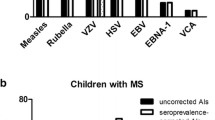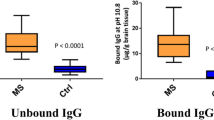Abstract
Human herpesvirus 6 (HHV-6) has been linked to the pathogenesis of multiple sclerosis (MS). HHV-6 antibodies in serum and cerebrospinal fluid (CSF) of 27 patients with clinically definite MS (CDMS) were compared with age- and sex-matched controls, including various other neurological diseases and symptoms (OND). In addition, we studied a series of 19 patients with clinically or laboratory supported possible MS (CPMS). Seroprevalence to HHV-6A was 100% in patients with MS, both in CDMS and CPMS, compared to 69.2% in patients with OND (P = .001 and .007). The mean immunoglobulin G (IgG) titers were significantly higher in patients with CDMS and CPMS than in controls (P = .005 and .00002). The proportion of acute primary infections without CSF involvement was similar in all groups; however, primary infections with intrathecal HHV-6 antibody production were more frequent in MS. In CSF, HHV-6A-specific antibodies were present in three (11.5%) and four (21.1%) patients with CDMS and CPMS, compared to none with OND (P = .06 and .01, respectively). Serological suggestions to HHV-6A infection occurred more often in both CDMS and CPMS than in OND (14.8% versus 21.1% versus 3.8%). We conclude that a subpopulation of MS patients, and even a greater proportion of possible MS subjects, has serological evidence of HHV-6A infection, which might provide new markers for diagnosis and therapy.
Similar content being viewed by others
References
Ablashi DV, Salahuddin SZ, Josephs SF, Imam F, Lusso P, Gallo RC, Hung C, Lemp J, Markham PD (1987). HBLV (or HHV-6) in human cell lines. Nature 329: 207.
Akhyani N, Berti R, Brennan MB, Soldan SS, Eaton JM, McFarland HF, Jacobson MS (2000). Tissue distribution and variant characterization of human herpesvirus (HHV)-6: increased prevalence of HHV-6A in patients with multiple sclerosis. J Infect Dis 182: 1321–1325.
Alvarez-Lafuente R, De Las Heras V, Bartolome M, Carcia-Montojo M, Arroyo R (2006). Human herpesvirus 6 and multiple sclerosis: a one-year follow-up study. Brain Pathol 16: 20–27.
Alvarez-Lafuente R, De Las Heras V, Bartolome M, Picazo JJ, Arroyo R (2004). Relapsing-remitting multiple sclerosis and human herpesvirus 6 active infection. Arch Neurol 61: 1523–1527.
Braun DK, Dominiguez G, Pellett PE (1997). Human herpesvirus 6. Clin Microbiol Rev 10: 521–567.
Campadelli-Fiume G, Mirandola P, Menotti L (1999). Human herpesvirus 6: an emerging pathogen. Emerg Infect Dis 5: 353–366.
Challoner PB, Smith KT, Parker JD, MacLeod DL, Coulter SN, Rose TM, Schultz ER, Bennett JL, Garber RL, Chang M, Schad PA, Stewart PM, Nowinski RC, Brown JP, Burmer GC (1995) Plaque-associated expression of human herpesvirus 6 in multiple sclerosis. Proc Natl Acad Sci USA 92: 7440–7444.
Chan PK, Ng HK, Hui M, Cheng AF (2001). Prevalence and distribution of human herpesvirus 6 variants A and B in adult human brain. J Med Virol 64: 42–46.
Chapenko S, Millers A, Nora Z, Logina I, Kukaine R, Murovska M (2003). Correlation between HHV-6 reactivation and multiple sclerosis disease activity. J Med Virol 69: 111–117.
Cuomo L, Trivedi P, Cardillo MR, Gagliardi FM, Vecchione A, Caruso R, Calogero A, Frati L, Faggioni A, Ragona G (2001). Human herpesvirus 6 infection in neoplastic and normal brain tissue. J Med Virol 63: 45–51.
Deisenhammer F, Bartos A, Egg R, Gilhus NE, Giovannoni G, Rauer S, Sellebjerg F; EFNS Task Force (2006). Guidelines on routine cerebrospinal fluid analysis. Report from an EFNS task force. Eur J Neurol 13: 913–922.
DeLorenze GN, Munger KL, Lennette ET, Orentreich N, Vogelman JH, Ascherio A (2006). Epstein-Barr virus and multiple sclerosis. Arch Neurol 63: 839–844.
Derfuss T, Hohlfeld R, Meinl E (2005). Intrathecal antibody (IgG) production against human herpesvirus type 6 occurs in about 20% of multiple sclerosis patients and might be linked to a polyspecific B-cell response. J Neurol 252: 968–971.
Friedman JE, Lyons MJ, Cu G, Ablashi DV, Whitman JE, Edgar M, Koskiniemi M, Vaheri A, Zabriskie JB (1999). The association of the human herpesvirus-6 and MS. Mult Scler 5: 355–362.
Friedman JE, Zabriskie JB, Plank C, Ablashi D, Whitman J, Shahan B, Edgell R, Shieh M, Rapalino O, Zimmerman R, Sheng D (2005). A randomized clinical trial of valacyclovir in multiple sclerosis. Mult Scler 11: 286–295.
Grigoriadis N, Hadjigeorgiou GM (2006). Virus-mediated autoimmunity in multiple sclerosis. J Autoimmun Dis 3: 1–8.
Hall CB, Caserta MT, Schnabel KC, Boettrich C, McDermott MP, Lofthus GK, Carnahan JA, Dewhurst S (2004). Congenital infections with human herpesvirus 6 (HHV-6) and human herpesvirus 7 (HHV-7). J Pediatr 145: 472–477.
Hall CB, Caserta MT, Schnabel K, Long C, Epstein LG, Insel RA, Dewhurst S (1998). Persistence of human herpesvirus 6 according to site and variant: possible greater neurotropism of variant A. Clin Infect Dis 26: 132–137.
Jääskelainen AJ, Piiparinen H, Lappalainen M, Koskiniemi M, Vaheri A (2006). Multiplex-PCR and oligonucleotide microarray for detection of eight different herpesviruses from clinical specimens. J Clin Virol 37: 83–90.
Josephs SF, Henry B, Balachandran N, Strayer D, Peterson D, Komaroff AL, Ablashi DV (1991). HHV-6 reactivation in chronic fatigue syndrome. Lancet 337: 1346–1347.
Knox KK, Brewer JH, Henry JM, Harrington DJ, Carrigan DR (2000). Human herpesvirus 6 and multiple sclerosis: systemic active infections in patients with early disease. Clin Infect Dis 31: 894–903.
Levine DP, Lauter CB, Lerner AM (1978). Simultaneous serum and CSF antibodies in herpes simplex virus encephalitis. JAMA 240: 356–360.
McDonald WI, Compston A, Edan G, Goodkin D, Hartung HB, Lublin FD, McFarland HF, Paty DW, Polman CH, Reingold SC, Sandberg-Wollheim M, Sibley W, Thompson A, van den Noort S, Weinschenker BY, Wolinsky JS (2001). Recommended diagnostic criteria for multiple sclerosis: Guidelines from the International Panel on the diagnosis of multiple sclerosis. Ann Neurol 50: 121–127.
Moore FGA, Wolfson C (2002). Human herpes virus 6 and multiple sclerosis. Acta Neurol Scand 106: 63–83.
Panitch HS (1994). Influence of infection on exacerbations of multiple sclerosis. Ann Neurol 36(Suppl): S25-S28.
Rotola A, Merlotti I, Caniatti L, Caselli E, Granieri E, Tola MR, Di Luca D, Cassai E (2004). Human herpesvirus 6 infects the central nervous system of multiple sclerosis patients in the early stages of the disease. Mult Scler 10: 348–354.
Salahuddin SZ, Ablashi DV, Markham PD, Josephs SF, Sturzenegger S, Kaplan M, Halligan G, Biberfeld B, Wong-Staal F, Kramarsky P, Gallo RC (1986). Isolation of a new virus, HBLV, in patients with lymphoproliferative disorders. Science 234: 596–600.
Salonen MJH, Siimes MA, Salonen E-M, Vaheri A, Koskiniemi M (2002). Antibody status to HHV-6 in children with leukaemia. Leukemia 16: 716–719.
Soldan SS, Leist TP, Juhng KN, McFarland HF, Jacobson S (2000). Increased lymphoproliferative response to human herpesvirus type 6A variant in multiple sclerosis patients. Ann Neurol 47: 306–313.
Virtanen JO, Zabriskie JE, Siren V, Friedman JE, Lyons MJ, Edgar M, Vaheri A, Koskiniemi M (2005). Colocalization of human herpesvirus 6 and tissue plasminogen activator in multiple sclerosis brain tissue. Med Sci Monit 11: BR84-BR87.
Ward KN, Andrews NJ, Verity CM, Miller E, Ross EM (2005). Human herpesviruses-6 and-7 each cause significant neurological morbidity in Britain and Ireland. Arch Dis Child 90: 619–623.
Ward KN, Gray JJ, Fotheringham MW, Sheldon MJ (1993). IgG antibodies to human herpesvirus-6 in young children in avidity of antibody correlate with time after infection. J Med Virol 39: 131–138.
Yamanishi K, Okuno T, Shiraki K, Takahashi M, Kondo T, Asano Y, Kurata T (1988). Identification of human herpesvirus-6 as a causal agent for exanthem subitum. Lancet ii: 1065–1067.
Author information
Authors and Affiliations
Corresponding author
Additional information
This study was partially funded by the Helsinki University Central Hospital Research Funds and supported by the Finnish Cultural Foundation.
Rights and permissions
About this article
Cite this article
Virtanen, J.O., Färkkilä, M., Multanen, J. et al. Evidence for human herpesvirus 6 variant A antibodies in multiple sclerosis: diagnostic and therapeutic implications. Journal of NeuroVirology 13, 347–352 (2007). https://doi.org/10.1080/13550280701381332
Received:
Revised:
Accepted:
Issue Date:
DOI: https://doi.org/10.1080/13550280701381332




